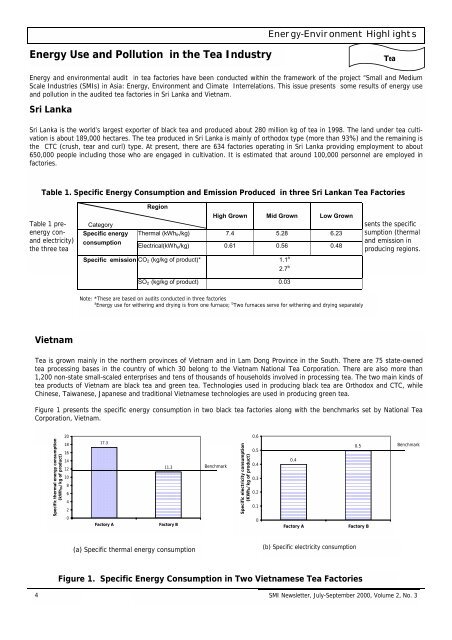Issue 6 - faculty.ait.ac.th - Asian Institute of Technology
Issue 6 - faculty.ait.ac.th - Asian Institute of Technology
Issue 6 - faculty.ait.ac.th - Asian Institute of Technology
Create successful ePaper yourself
Turn your PDF publications into a flip-book with our unique Google optimized e-Paper software.
Energy Use and Pollution in <strong>th</strong>e Tea Industry<br />
Energy-Environment Highlights<br />
Energy and environmental audit in tea f<strong>ac</strong>tories have been conducted wi<strong>th</strong>in <strong>th</strong>e framework <strong>of</strong> <strong>th</strong>e project “Small and Medium<br />
Scale Industries (SMIs) in Asia: Energy, Environment and Climate Interrelations. This issue presents some results <strong>of</strong> energy use<br />
and pollution in <strong>th</strong>e audited tea f<strong>ac</strong>tories in Sri Lanka and Vietnam.<br />
Sri Lanka<br />
Sri Lanka is <strong>th</strong>e world’s largest exporter <strong>of</strong> bl<strong>ac</strong>k tea and produced about 280 million kg <strong>of</strong> tea in 1998. The land under tea cultivation<br />
is about 189,000 hectares. The tea produced in Sri Lanka is mainly <strong>of</strong> or<strong>th</strong>odox type (more <strong>th</strong>an 93%) and <strong>th</strong>e remaining is<br />
<strong>th</strong>e CTC (crush, tear and curl) type. At present, <strong>th</strong>ere are 634 f<strong>ac</strong>tories operating in Sri Lanka providing employment to about<br />
650,000 people including <strong>th</strong>ose who are engaged in cultivation. It is estimated <strong>th</strong>at around 100,000 personnel are employed in<br />
f<strong>ac</strong>tories.<br />
Table 1. Specific Energy Consumption and Emission Produced in <strong>th</strong>ree Sri Lankan Tea F<strong>ac</strong>tories<br />
High Grown Mid Grown Low Grown<br />
Table 1 pre- Category<br />
sents <strong>th</strong>e specific<br />
energy conand<br />
electricity)<br />
<strong>th</strong>e <strong>th</strong>ree tea<br />
Specific energy<br />
consumption<br />
Thermal (kWh<strong>th</strong>/kg)<br />
Electrical(kWhe/kg)<br />
7.4<br />
0.61<br />
5.28<br />
0.56<br />
6.23<br />
0.48<br />
sumption (<strong>th</strong>ermal<br />
and emission in<br />
producing regions.<br />
CO2 (kg/kg <strong>of</strong> product)* 1.1 a<br />
Specific emission<br />
Vietnam<br />
Region<br />
Tea is grown mainly in <strong>th</strong>e nor<strong>th</strong>ern provinces <strong>of</strong> Vietnam and in Lam Dong Province in <strong>th</strong>e Sou<strong>th</strong>. There are 75 state-owned<br />
tea processing bases in <strong>th</strong>e country <strong>of</strong> which 30 belong to <strong>th</strong>e Vietnam National Tea Corporation. There are also more <strong>th</strong>an<br />
1,200 non-state small-scaled enterprises and tens <strong>of</strong> <strong>th</strong>ousands <strong>of</strong> households involved in processing tea. The two main kinds <strong>of</strong><br />
tea products <strong>of</strong> Vietnam are bl<strong>ac</strong>k tea and green tea. Technologies used in producing bl<strong>ac</strong>k tea are Or<strong>th</strong>odox and CTC, while<br />
Chinese, Taiwanese, Japanese and traditional Vietnamese technologies are used in producing green tea.<br />
Figure 1 presents <strong>th</strong>e specific energy consumption in two bl<strong>ac</strong>k tea f<strong>ac</strong>tories along wi<strong>th</strong> <strong>th</strong>e benchmarks set by National Tea<br />
Corporation, Vietnam.<br />
Specific <strong>th</strong>ermal energy consumption<br />
(kWh<strong>th</strong>/kg <strong>of</strong> product)<br />
20<br />
18<br />
16<br />
14<br />
12<br />
10<br />
8<br />
6<br />
4<br />
2<br />
0<br />
Figure 1. Specific Energy Consumption in Two Vietnamese Tea F<strong>ac</strong>tories<br />
4 SMI Newsletter, July-September 2000, Volume 2, No. 3<br />
2.7 b<br />
SO2 (kg/kg <strong>of</strong> product) 0.03<br />
Note: *These are based on audits conducted in <strong>th</strong>ree f<strong>ac</strong>tories<br />
a Energy use for wi<strong>th</strong>ering and drying is from one furn<strong>ac</strong>e; b Two furn<strong>ac</strong>es serve for wi<strong>th</strong>ering and drying separately<br />
17.3<br />
11.3<br />
F<strong>ac</strong>tory A F<strong>ac</strong>tory B<br />
(a) Specific <strong>th</strong>ermal energy consumption<br />
Benchmark<br />
Specific electricity consumption<br />
(KWhe/kg <strong>of</strong> product)<br />
0.6<br />
0.5<br />
0.4<br />
0.3<br />
0.2<br />
0.1<br />
0<br />
0.4<br />
(b) Specific electricity consumption<br />
0.5<br />
F<strong>ac</strong>tory A F<strong>ac</strong>tory B<br />
Tea<br />
Benchmark
















